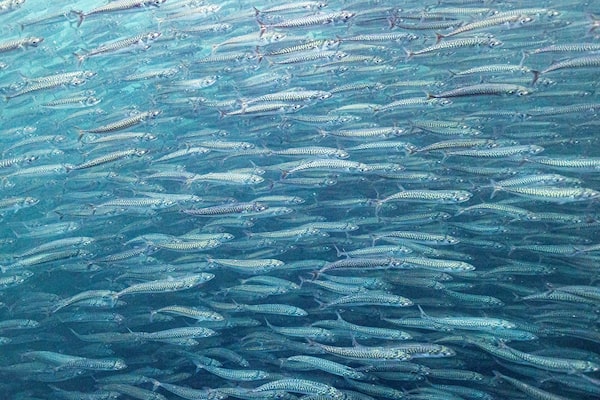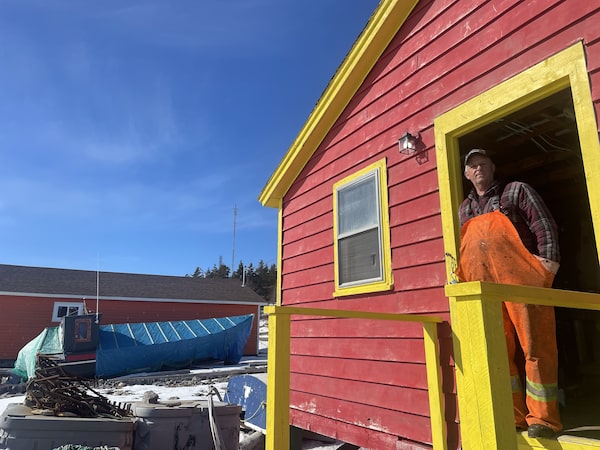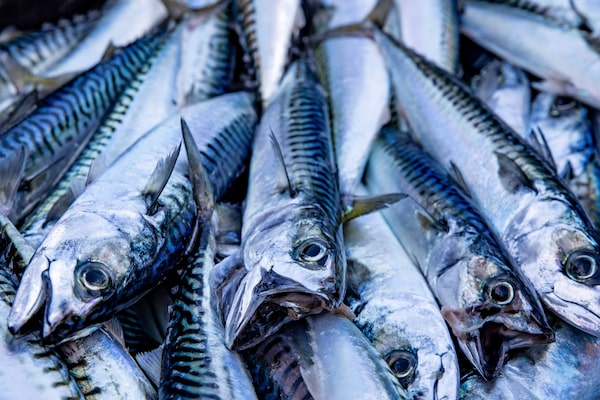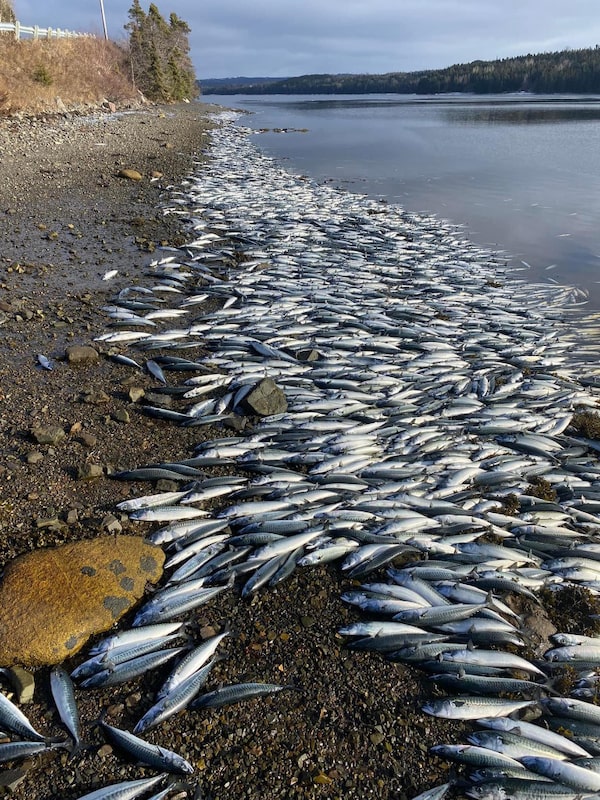:format(jpeg)/cloudfront-us-east-1.images.arcpublishing.com/tgam/VBJHPXMVBJFNJFOCDV7GXMYRSY.jpg)
Schools of Atlantic mackerel return to Canada’s eastern shores each spring, and so do shoreline fishermen like Terry Couisineau.
As a boy, Mr. Couisineau reeled in the day’s reward by the bucketful: torpedo-shaped fish with black racing stripes and turquoise-silver bodies glinting in the sunlight. Atlantic mackerel, sometimes called the people’s fish, can be caught from shore – no boat, fishing licence or expensive gear required.
But the Dartmouth, N.S. resident, now 49 years old, worries that his days spent shoreline fishing are numbered, because the mackerel population is dwindling. “When I was a kid, we had challenges to cast out and not return with a fish. Nowadays, it’s all mostly tinks,” he said, alluding to the smaller mackerel he sees today, compared to those he remembers catching two decades ago.
Canada’s Atlantic mackerel population is a shadow of what it once was, and its decline threatens the well-being of the people who depend on it. Mackerel supports one of Atlantic Canada’s top recreational fisheries, and one of its oldest commercial fisheries. The fish is also used for bait, and it has an important place in Indigenous cultures. The same migratory stock supports recreational and commercial fisheries in the U.S.

A school of Atlantic mackerel, sometimes called the "people’s fish," swim beneath the ocean surface near Halifax, N.S.Nicolas Winkler/The Globe and Mail
Last March, the federal Department of Fisheries and Oceans closed Canada’s commercial and bait mackerel fisheries for one year and placed daily personal limits on the recreational fishery, to give the population time to rebound. But the U.S. fishery remains open, albeit with a reduced quota.
Next week, federal Fisheries Minister Joyce Murray will decide whether to reopen the Canadian fishery. The DFO’s latest studies have found no sign of recovery in the mackerel stock.
According to the department, mackerel’s spawning stock biomass (a measure of the abundance of adult mackerel) has seesawed over the past decades, from a high of 386,314 tonnes in 1990 to a historic low of 27,599 tonnes in 2020, with a few peaks and valleys in between. Scientists say these boom-and-bust cycles belie a longer-term mackerel decline.
Since the 1980s, the population’s age structure has collapsed, meaning it is now dominated by younger and smaller-sized fish producing fewer eggs. At the same time, the rate of fishing has increased, particularly between 1990 and 2011.
Climate Innovators and Adaptors
This is one in a series of stories on climate change related to topics of biodiversity, urban adaptation, the green economy and exploration, with the support of Rolex. Read more about the Climate Innovators and Adaptors program.
By 2011, the biomass of the mackerel stock was in what the DFO calls the “critical zone” – a point so low that serious harm occurs. The department’s latest assessment puts the mackerel stock biomass at 42 per cent of the critical zone threshold, with no significant signs of growth since 2015.
Boyd Lavers, a commercial fisherman in Port Saunders, on the Northern Peninsula of Newfoundland, had been catching mackerel for almost two decades before last year’s moratorium barred him from doing so.

Fish harvester Patrick Payne stands in his gear shed on Port Saunders harbour in Newfoundland. Impacted by the changes to mackerel fishing, Payne must find new sources of bait to use in his lobster traps.Leila Beaudoin/The Globe and Mail
Port Saunders was one of the hardest hit communities when the federal government closed the commercial cod fishery in 1992. Mr. Lavers was 19 years old at the time, and he stuck it out in the local industry as it shifted from groundfish, such as cod, to plentiful (and more profitable) shellfish, such as shrimp and snow crab.
In 2007, during a decade when mackerel catches were 10 times what they have been in more recent years, he bought a new 45-foot longliner for mackerel fishing. Now, with mackerel’s outlook grim, the 49-year-old captain has reluctantly slapped a “for sale” sign on his prized fishing vessel.
“Fishing boats are 20-year investments, and I’d hoped to get another 15 years out of her,” Mr. Lavers said. In 2022, he made ends meet fishing shrimp, herring and capelin. But like mackerel, other forage fish populations, including herring and capelin, are waning.

Mackerel caught for lobster bait in Sydney, N.S.Nicolas Winkler/The Globe and Mail

When Atlantic mackerel washed up dead on the shores of Bonavista Bay in Charleston, Newfoundland in late December 2022, fishers argued the stock was overly abundant, but scientists say the die-off was likely due to a flash freeze event and that the stock is in the critical zone.Alf Pike/The Globe and Mail
Last year, the DFO closed the commercial spring herring fishery in the Southern Gulf of St. Lawrence. The Scotian Shelf and Bay of Fundy herring stocks are in the critical zone. All told, 24 per cent of Canada’s forage fish stocks are in the critical zone, while a scant 6 per cent are healthy.
But that’s not what fishermen are reporting seeing out on the water. Dozens of photos and videos shared in fishermen’s forums and on social media throughout 2022 show seemingly abundant Atlantic mackerel populations.
“Closure without cause” is how the Fish, Food and Allied Workers Union, a Newfoundland and Labrador fishermen’s union, describes the mackerel moratorium in its latest campaign. According to the union, fishermen throughout the province have reported unprecedented levels of mackerel this past year.
But scientists have found that the apparent abundance of mackerel is misleading. They have pointed to “hyperaggregation” as a cause. When populations of schooling fish such as mackerel dwindle, the remaining fish cluster in increasingly tight, dense schools. This behavioural response can create an appearance of plenty. And it can precede a sudden population collapse.
Another reason the mackerel population can appear to fluctuate is migration, which can shift with temperature changes. The fish have a geographic range extending as far north as northern Newfoundland and Labrador and as far south as North Carolina.
“Ultimately, mackerel will go where there are relatively better environmental conditions – more food available and better temperature,” the DFO’s fisheries management plan for mackerel says.
But the union is still skeptical of the DFO’s science, which it referred to in a recent news release as “unfounded environmentalist dogma.”
“Fish harvesters and this union are not anti-science – that’s not what this is about. But when decisions on whether to open or close fisheries become ideology-driven rather than evidence-driven, our federal government has clearly lost its way,” union president Greg Pretty is quoted as saying in the release.
Other fishermen’s unions believe the science, but think the stock can be rebuilt with quotas, rather than full shutdowns. In a news release from the Maritime Fishermen’s Union, which represents unions in New Brunswick, Nova Scotia, PEI and Quebec, the group urges the DFO to follow the National Oceanic and Atmospheric Administration (NOAA) – the DFO’s counterpart in the U.S. – by opening limited mackerel commercial and bait fisheries.
:format(jpeg)/cloudfront-us-east-1.images.arcpublishing.com/tgam/YLJZOOR5WJDJROZ3P2O5HUMSRY.jpg)
:format(jpeg)/cloudfront-us-east-1.images.arcpublishing.com/tgam/DIDNDN6XEFEFJKW2GONSDBMEAQ.jpg)
“We believe the science. There are some gaps. But if you keep a low-quota fishery, like 2,500 tonnes, the stock will rebuild over that threshold of the precautionary zone,” MFU executive director Martin Mallet said in an interview.
Yet scientists say limited-quota fisheries delay stock rebuilding. The DFO’s latest mackerel assessment suggests that, even with the fishery closed, the stock has only a 38-per-cent chance of exiting the critical zone within two years.
Mackerel recovery is far from certain, and many complicating factors could delay or stall it. For instance, while the fishery is closed, mackerel are still being fished for bait in largely unknown quantities, because DFO monitoring is less stringent in this area. What is known is that the demand for fisheries that rely on mackerel for bait, primarily lobster and crab, has dramatically increased over the past 30 years.
“We need to get the bait situation under control, because if the major market is still alive and wanting to fish more mackerel, that’s always going to be a factor in the recovery,” said Katie Schleit, the fisheries director with the marine research conservation group Oceans North.
And then there is the U.S. mackerel fishery. There are two mackerel populations in North America. The northern contingent is Canada’s stock. It is primarily fished in Canada, but it migrates to the U.S., where it is also fished. There is also a southern contingent that is fished exclusively in the U.S.
It’s just devastating
— Conway Caines, fisherman from Port Saunders N.F.L.
Fisherman Conway Caines talks about losing his licence to fish for mackerel.
The Globe and Mail
In 2022, with the Canadian fishery closed, the U.S. fishery stayed open, allowing harvesting of the same depleted northern stock. In early February, NOAA announced that the U.S. commercial mackerel fishery would stay open in 2023, with a nearly 30-per-cent quota reduction, from 4,963 tonnes last year to 3,639 this year.
It’s unknown how much of the mackerel caught in the U.S. is from the northern contingent, but the DFO has reported that the proportion is “likely to be high,” meaning up to 80 per cent. And the impact of that fishing is poorly understood. That’s a major sticking point for Canadian fishermen.
“If the U.S. had a complete moratorium, we would probably be sitting back and taking this medication and waiting. But why can’t we just fish it ourselves?” Mr. Mallet said.
“The Canadian closure leaves more fish in the water for American fishers while hanging Canadian fishers out to dry,” Mr. Lavers said.
To further complicate matters, there are reports of Canadian lobster fishermen importing mackerel bait from the U.S. fishery.
“They’re importing fish that we would consider undersized fish, because the U.S. doesn’t have a size limit,” Ms. Schleit said.
She noted that the U.S. has progressively reduced its commercial mackerel catch, from 17,312 tonnes in 2020, to 4,963 in 2021, to 3,639 in 2022. “If we can continue to get the U.S. to ratchet down its fishery, Canada should do that,” she said.
:format(jpeg)/cloudfront-us-east-1.images.arcpublishing.com/tgam/2I35UXBFDRFXDHXFHRWJQQ4A7Y.jpeg)
:format(jpeg)/cloudfront-us-east-1.images.arcpublishing.com/tgam/Z3PBJ5MZAJALVPTC3NRPISMT7M.jpeg)
Climate change adds to the uncertainty of a mackerel recovery. The DFO has said that changing water temperatures affect where mackerel are found and how many are caught. But climate conditions are not considered in quota decisions, or in the mackerel rebuilding plan.
With a decision on the 2023 mackerel fishery expected soon, conservationists say these uncertainties compel the Fisheries Minister not to cave to pressure from fishermen’s unions.
“She needs to stay the course. She has even more evidence this year, scientifically, that closing the commercial and bait fisheries is the right thing to do,” Ms. Schleit said.
Of the various measures the DFO could take, a moratorium represents “the sharpest tool in our toolbox,” she added.
“That’s a very drastic measure. But this stock requires drastic action. We’re deep in the critical zone and have been for 10 years. The critical zone is a place where you’re never supposed to go. It’s called the critical zone because that’s where serious damage could be occurring to the stock.”
Much is at stake in the Minister’s decision. The landed value of mackerel is only 0.1 per cent of Canada’s current $6-billion annual fishing industry. But this valuation doesn’t capture the broader economic benefit of mackerel and other small forage fish, which is thought to be more than three times their catch value. They create jobs in aquaculture, farming, retail, tourism, distribution and processing.

Woven into the fabric of east coast life, mackerel provide a vital food source and a conduit for social connection for many.Nicolas Winkler/The Globe and Mail
Through the shoreline fishery, mackerel have also become woven into the fabric of east coast life. For many, they provide a vital food source and a conduit for social connection. Because of this, shoreline mackerel fishing is increasingly popular with newcomers to Canada, who gravitate to it to connect with their new environment and find community.
“Fishing is about the best way to bring all the different communities together,” said Mr. Couisineau, the shoreline fisherman. “You can sit there with someone who can’t speak English, and you just smile and nod your head. You have something in common.”
The most rewarding part about mackerel fishing, he said, is that it’s for everyone.
He’s hoping to see the healthy mackerel schools of his youth return, and the people on the shore with them.
Daniel Boyce is an adjunct professor at Dalhousie University and a contract research scientist with the Department of Fisheries and Oceans. His work focuses on climate risk for marine life. He has no connection to the mackerel fishery or its management.
Jenn Thornhill Verma is a fellow of the Royal Canadian Geographical Society and the author of Cod Collapse: The Rise and Fall of Newfoundland’s Saltwater Cowboys.